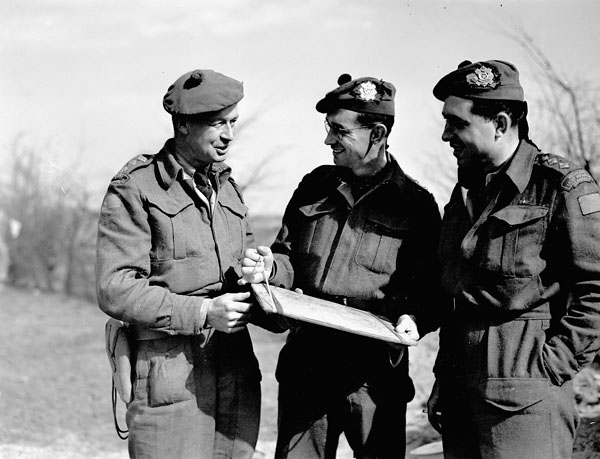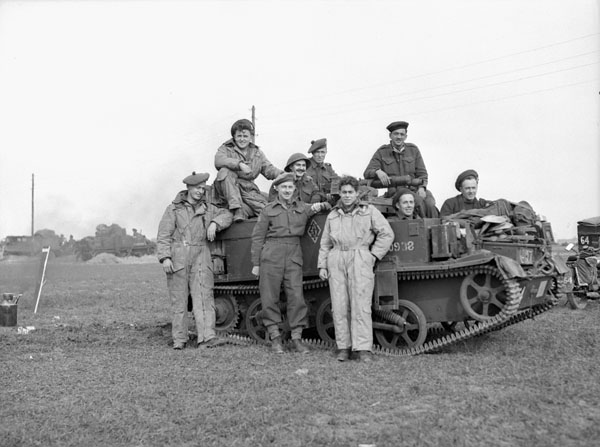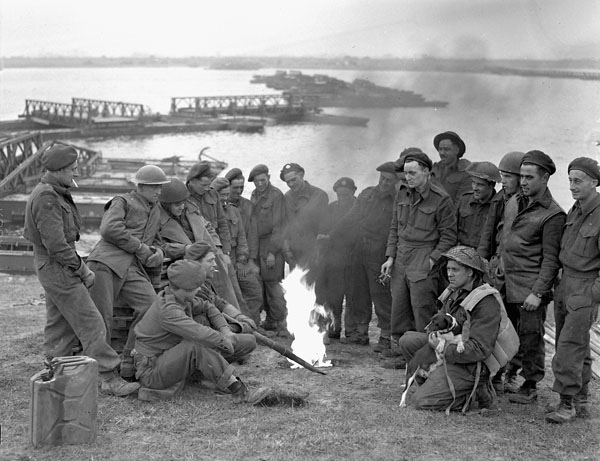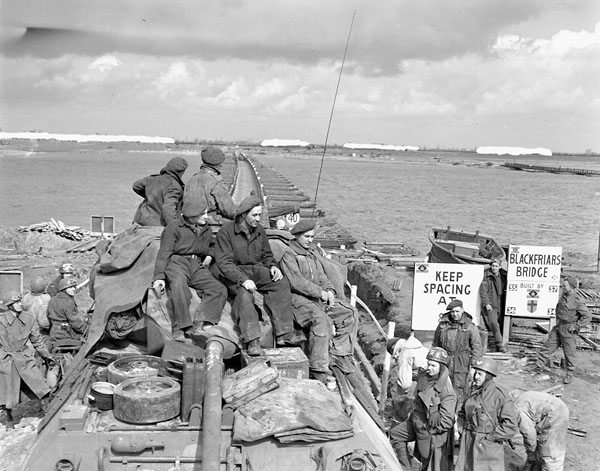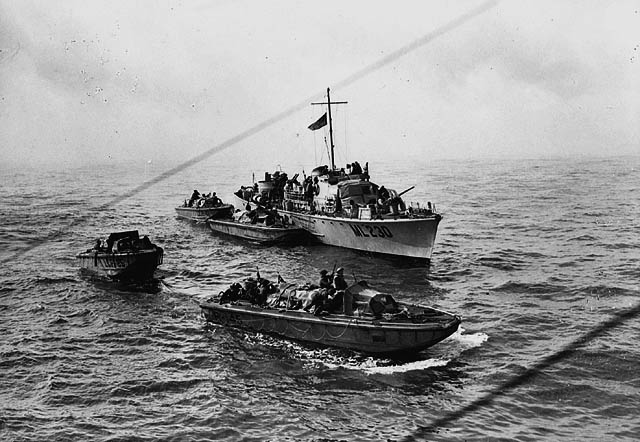The Rhineland Offensive (8 February–24 March 1945) was one of the last major European campaigns of the Second World War. In what was some of the bitterest fighting of the war, First Canadian Army and Ninth US Army forced the Germans back to the Rhine River. For the Canadian army, the first phase was Operation Veritable (8–21 February), an attack over inundated ground in the Reichswald forest. The second phase, Operation Blockbuster (26 February–10 March), was a gruelling attack through the Hochwald Forest. Canadians were also involved in Operation Plunder (23 March–1 April), an assault across the Rhine and expansion of the bridgehead, and Operation Varsity (24 March), an airborne assault. Under General Harry Crerar, First Canadian Army fought tough battles in the Reichswald and the Hochwald, preparing the way for the Allies to cross the Rhine and enter Germany. More than 5,300 Canadians were killed, wounded or captured during the campaign.

Background
On 7 November 1944, the Scheldt campaign ended. First Canadian Army had cleared the Scheldt estuary and opened the port of Antwerp to Allied merchant shipping. The Canadians then had a three-month period of relative inactivity until 8 February 1945.
Known as the Winter on the Maas (the Dutch name for the Meuse River), this period was marked by aggressive patrol activity to give the enemy the impression an attack was imminent. The pause was also an opportunity to replace the men and equipment lost during the Scheldt battles.
Adolf Hitler, however, had other ideas. On 16 December, the German Army launched a massive surprise attack through the Ardennes. Its goal was to split the Anglo-Canadian armies in the north from the American armies in the south and reach Antwerp. Although the Battle of the Bulge was a failure and the last great German offensive in the west, it delayed the Allied winter offensive until February 1945.
Field Marshal Bernard Montgomery commanded 21st Army Group, which consisted at the time of First Canadian Army, Second British Army and Ninth US Army. Possessing vastly superior numbers of men and materiel, Montgomery wanted to destroy the enemy west of the Rhine in a huge battle of attrition.
While Second British Army pinned down the Germans facing it along the Maas and planned for a later crossing of the Rhine, General Harry Crerar’s First Canadian Army would assault from the north and the Ninth US Army would attack from the south in a giant pincer movement. First Canadian Army’s strength rose to almost 450,000 Canadian, British and other nationalities — the largest force ever commanded by a Canadian.
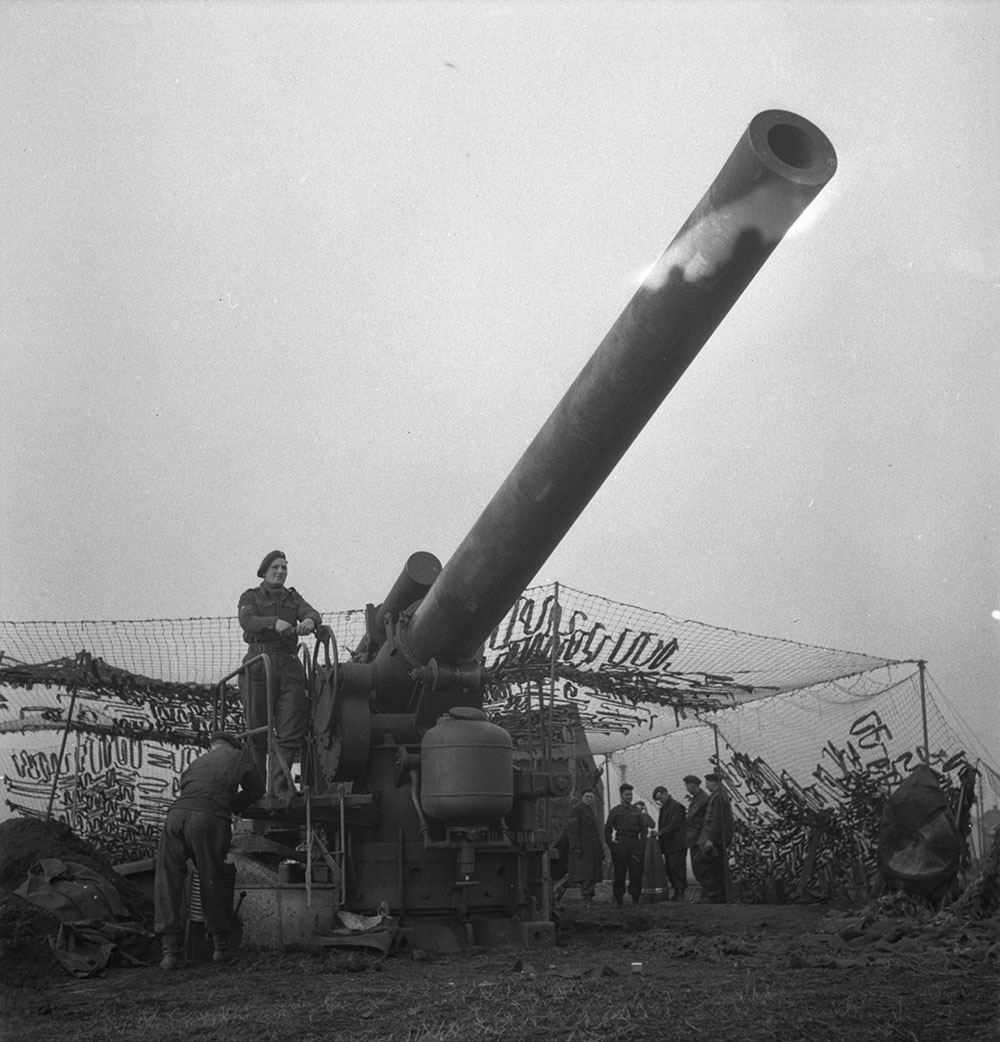
Operation Veritable
Crerar’s Anglo-Canadian army faced three major obstacle lines across its advance. The first was a series of strong outposts, followed by the West Wall or Siegfried Line running through the Reichswald. The last was the Hochwald layback position in the Hochwald Forest, covering the final approach to the Rhine at Xanten. Each line consisted of antitank ditches, minefields, concrete weapons bunkers and antitank obstacles known as “dragon’s teeth.” Villages between the lines were strongly fortified.
A substantial German force with strong reserves blocked the Allied advance. Due to the narrow front between the Maas and Rhine Rivers, Crerar assigned the initial phase to XXX British Corps under Lieutenant-General Brian Horrocks. He also gave Horrocks operational control of 2nd and 3rd Canadian Infantry Divisions for the battle. XXX Corps now consisted of one armoured and six infantry divisions, plus three armoured brigades. Once the Reichswald was cleared, II Canadian Corps would enter the line on the left.
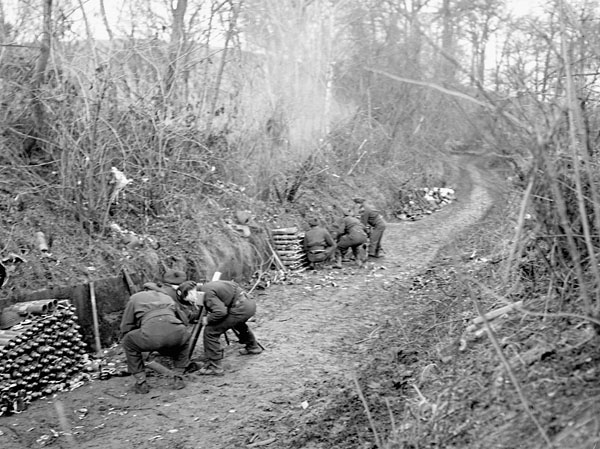
At 10:30 a.m. on 8 February 1945, Operation Veritable, the opening phase of the Battle of the Rhineland, was launched in a southeasterly direction from Nijmegen. Behind a massive barrage of artillery and air support, four divisions made the initial attack, including 2nd Canadian Division on the left. Sherman tanks led the way but had difficulty in the muddy morass created by the weather and bombardment. The Germans had also blown dykes along the Rhine, flooding much of the terrain in the northern sector.
That afternoon, 3rd Division entered the battle on the left, carried across the flooded landscape in armoured, amphibious tracked Buffaloes. It reminded 3rd Division soldiers of their nickname, “Water Rats,” from the polder fighting in the Scheldt the previous fall. Supplies were carried in amphibious and tracked, but unarmoured, DUKWs.
By February 10, the Canadians had broken through the Siegfried Line and, after three days of brutal fighting, had cleared the Reichswald. The next task was to move through Moyland Wood, a small forest beyond the Reichswald. It took a week to overcome the heavily fortified position. While this was happening, the front had widened enough that II Canadian Corps was able to enter the line on the left on 15 February.
The next obstacle was the defended road running from Goch to Calcar, which stretched across the advance at right angles. The Royal Hamilton Light Infantry and the Essex Scottish attacked on 19 February, mounted in Kangaroos — improvised armoured personnel carriers made from deturreted Canadian Ram tanks. Each battalion was also supported by a squadron of Fort Garry Horse Shermans. The attack immediately ran into fire from 88mm guns and tanks.
Compounding the German response was the sodden ground; several tanks and Kangaroos soon bogged down in the mud. In response, the Canadians dug in. That night, the Germans counterattacked and overran some of the Canadian positions. The next day, the Royal Regiment of Canada and the third squadron of the Garrys arrived to support the two beleaguered battalions.
After a fierce and costly battle, the remaining Germans withdrew on the morning of 20 February. Operation Veritable was over; Operation Blockbuster was next. But first, a few days were needed for rest, recovery and replenishment.
Operation Blockbuster
Operation Blockbuster began at 3:45 a.m. on 26 February 1945. The 2nd and 3rd Canadian Divisions led the way toward the Hochwald Forest, attacking on a 2,750-metre front behind a massive barrage. A lengthy opening ran through the centre of the forest, known as the Hochwald Gap. It carried the Goch-Xanten railway line, which was vital to the future advance of II Corps toward the Rhine.
As the Canadians advanced, the Queen’s Own Rifles came up against Mooshof, a strongly defended farm complex. During the engagement, Sergeant Aubrey Cosens drove back counterattacking Germans and cleared three farm buildings. As he returned to report to his company commander, he was killed by a sniper’s bullet. Cosens was awarded a posthumous Victoria Cross.
As the Canadians pressed forward, the Germans withdrew to their next prepared positions. Once Canadians neared the new line, heavy enemy artillery and mortar fire fell on them, followed by strong counterattacks. But the Germans were forced back, suffering heavy casualties in the process.
At dawn on 27 February, units of 4th Canadian Armoured Division attacked into the Gap and eventually breached the last German defences before the Rhine. They met fierce enemy resistance, which caught the Canadians in a narrow defile and stopped the advance. An attack by new units the next day also ground to a halt and was held up for three days.
On 1 March, 6th Canadian Infantry Brigade moved into line, its lead company under Major Fred Tilston of the Essex Scottish. During the initial attack, Tilston was wounded three times but continued to lead his men forward until loss of blood forced him to hand over command. Tilston lost both legs as a result and received the Victoria Cross for his gallantry.
The 4th Armoured Brigade drove for the Rhine with its infantry mounted in Kangaroos. German counterattacks stopped the advance, and more heavy fighting followed. On 8 March, the Hochwald was finally cleared and the town of Xanten beyond it captured.
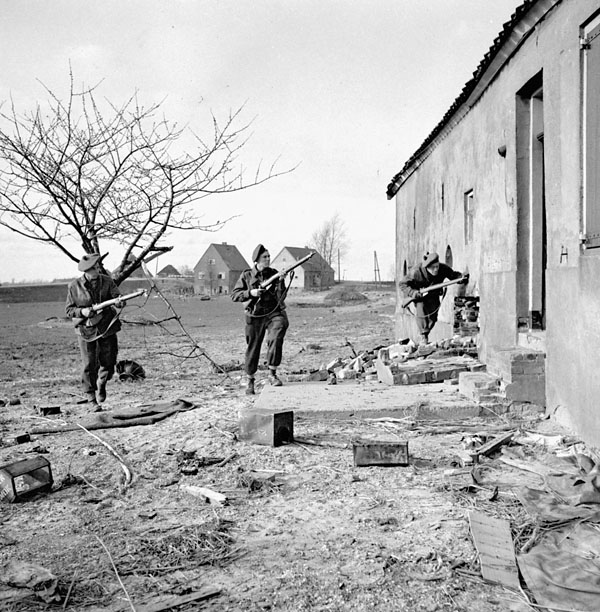
Operation Plunder
Now that the Allies had reached the Rhine, they had to cross the last major natural obstacle to their advance into Germany. Montgomery selected Second British Army and Ninth US Army for Operation Plunder, an assault water crossing of the Rhine. Initially, this did not include Canadian soldiers. After Crerar, however, protested that his men deserved to participate, Montgomery relented and attached II Canadian Corps to Second British Army.
Preparations for the operation were extensive. More than 250,000 tons of supplies were stockpiled, 4,000 artillery guns assembled, and new approach roads built. Beginning on 16 March, a massive smoke screen more than 100 km wide (the largest to that date) hid these preparations from German view.
Second British Army crossed the Rhine between Rees and Wesel, beginning on the night of 23 March. Two Scottish infantry divisions crossed first, followed by a commando brigade, carried across in Buffaloes. When a Scottish battalion ran into stiff opposition north of Rees, 9th Canadian Infantry Brigade crossed in Buffaloes to relieve them early on 24 March.
The Highland Light Infantry (HLI) led the brigade and soon encountered fierce resistance from German paratroopers. The HLI fought on and captured their objectives north of Rees. Similarly, the brigade’s other two battalions, the Stormont, Dundas and Glengarry Highlanders and the North Nova Scotia Highlanders, encountered German soldiers who fought fiercely. On 25 March, the North Novas had a particularly tough fight at Bienen; by the end of the battle, it had lost 30 percent of its strength.
By 27 March, all of 3rd Canadian Division had crossed the Rhine. It soldiers captured Emmerich and the Hoch Elten, a nearby high feature. Royal Canadian Engineers followed the assault and constructed three bridges across the Rhine for following troops to cross.
Operation Varsity
Operation Varsity began on 24 March 1945 at 10:00 a.m., shortly after Operation Plunder was launched. In the largest ever single-day airborne drop, about 14,000 paratroopers of the 6th British and 17th US Airborne Divisions jumped east of the Rhine to seize important ground. The 6th Airborne Division included 475 men of 1st Canadian Parachute Battalion as part of its 3rd Parachute Brigade.
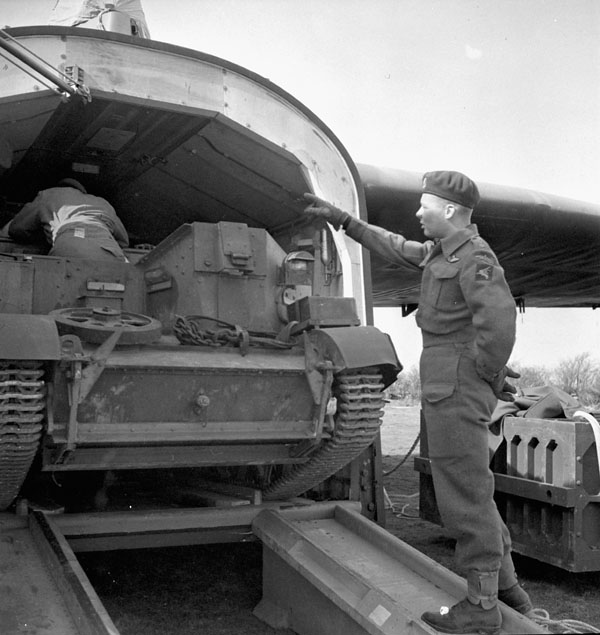
The Canadian battalion landed north of Diersfort Wood, spread over a wide area. The paratroopers immediately encountered heavy machine-gun and sniper fire but by 11.30 a.m. had cleared their objectives, in the process killing or capturing hundreds of Germans. The Canadians suffered 65 casualties, including the unit’s commanding officer, Lieutenant-Colonel Jeff Nicklin. The prewar star football player was found dangling from a tree still in his parachute, his body riddled with bullets.
One of the battalion’s medical orderlies, Corporal Fred Topham, distinguished himself during the operation. As he treated a wounded man out in the open under fire, he was shot in the face but carried the wounded soldier to safety. Despite his wound, Topham continued to treat other casualties and later rescued three men from a burning carrier. He received the Victoria Cross for his bravery.
Significance
After the initial debacles at Hong Kong and Dieppe, the Canadian army went on to successful campaigns in Sicily, the Italian peninsula and across northwest Europe into Germany. The Rhineland Offensive was the last large campaign in the west and one in which Canada played a key role. Under Crerar, First Canadian Army fought tough battles in the Reichswald and the Hochwald, preparing the way for the Allies to cross the Rhine and enter the German homeland.
On 26 March, General Dwight D. Eisenhower, the Supreme Commander Allied Forces Europe, wrote the following to Crerar:
The purpose of this note is to express to you personally my admiration for the way you conducted the attack by your Army, beginning on February 8 and ending when the enemy had evacuated his last bridgehead at Wesel. Probably no assault in this war has been conducted under more appalling conditions of terrain than was that one. It speaks volumes for your skill and the valor of your soldiers, that you carried it through to a successful conclusion.

 Share on Facebook
Share on Facebook Share on X
Share on X Share by Email
Share by Email Share on Google Classroom
Share on Google Classroom
